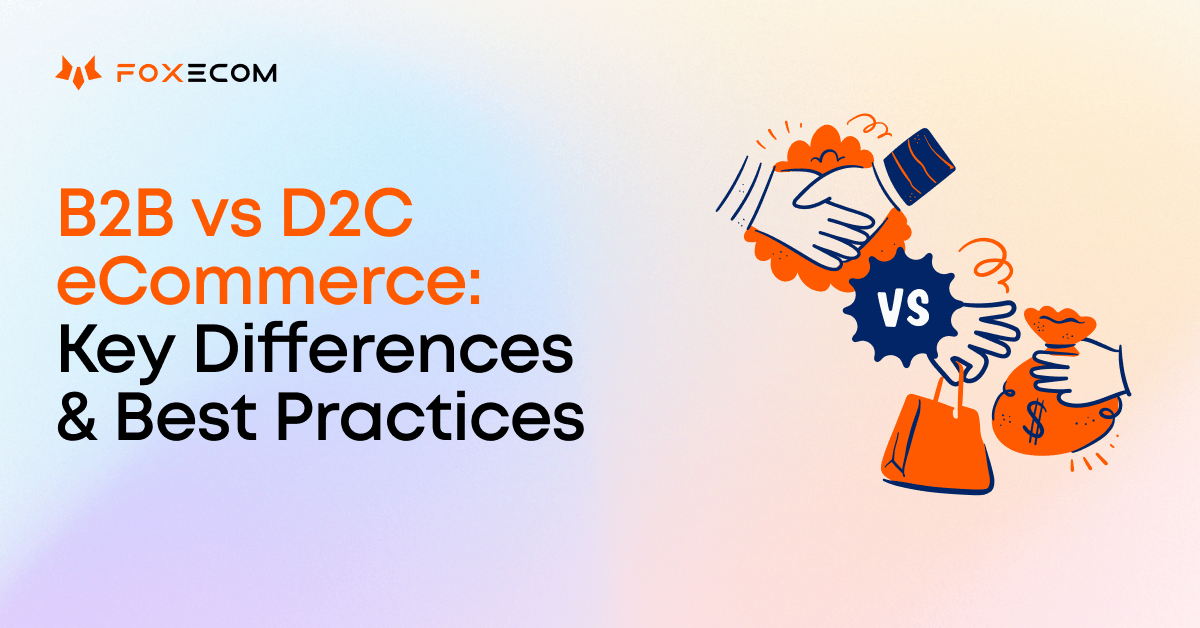Exploring the Prospective of D2C Ecommerce: A Comprehensive Overview for Companies
The D2C ecommerce model offers a substantial shift in exactly how brands involve with consumers. It allows companies to bypass typical retail networks, fostering much deeper links and potentially boosted earnings margins. This strategy is not without its complexities. Understanding the nuances of D2C ecommerce is important for brands intending to flourish. What strategies can they adopt to browse this evolving landscape effectively? The answers might redefine their business strategies.
Recognizing the D2C Ecommerce Model

Trick Conveniences of D2C Ecommerce for Brands
The D2C ecommerce version provides brands significant advantages, particularly regarding enhanced earnings margins. By eliminating intermediaries, firms can preserve a bigger share of sales earnings. In addition, this straight relationship with customers fosters improved brand name loyalty, motivating repeat acquisitions and long-term engagement.
Increased Earnings Margins

Boosted Brand Name Loyalty
Structure on the financial advantages of D2C ecommerce, improved brand commitment becomes another crucial advantage for companies engaging straight with consumers. By establishing a straight connection, brand names can promote deeper relationships with their clients, getting insights right into behaviors and preferences. This straight communication permits even more individualized marketing methods, which resonate strongly with customers. Additionally, brand names have the opportunity to regulate their messaging and consumer experience, enhancing brand name values and constructing trust fund. When customers feel an individual link, they are more probable to return, advocate for the brand, and take part in area interaction. Ultimately, enhanced brand name commitment not only drives repeat acquisitions yet additionally cultivates an enthusiastic consumer base, further strengthening a brand's position in the marketplace.
Difficulties Faced by D2C Brands
D2C brands run into a number of substantial difficulties that can influence their success. Stock monitoring problems can result in equip shortages or excess, complicating procedures and client contentment. In addition, marketing spending plan restraints often limit the capacity to effectively get to and engage target audiences.
Stock Monitoring Issues
Effective inventory administration provides a powerful obstacle for numerous brands running in the direct-to-consumer (D2C) space. These brands usually come to grips with fluctuating need, which can result in overstock or stockouts, inevitably influencing consumer contentment and profits. Additionally, the absence of sophisticated stock monitoring systems can result in disparities between actual supply degrees and reported data, making complex order gratification. The varied variety of items D2C brands normally offer also makes complex inventory monitoring, as variations in styles, colors, and dimensions require more careful oversight. Several D2C services may battle with minimal warehousing capacities, leading to ineffective use of area and resources. Consequently, efficient inventory monitoring stays a critical hurdle for D2C brand names going for lasting development and operational performance.
Marketing Spending Plan Constraints
Steering advertising and marketing budget plan restraints is a significant obstacle for several direct-to-consumer (D2C) brands. Minimal funds usually restrict these firms' capability to buy all-encompassing marketing techniques, causing lowered visibility in an open market. D2C brand names often come to grips with the demand to take full advantage of roi (ROI) while targeting specific target markets properly. This useful content difficulty is exacerbated by climbing expenses in electronic advertising and marketing and the requirement to allocate funds throughout numerous networks, consisting of social media sites, online search engine, and e-mail advertising and marketing. Numerous D2C brand names should introduce affordable marketing options, leveraging natural growth methods and influencer partnerships. Inevitably, efficiently maneuvering these budget plan restrictions is necessary for sustaining growth and attaining long-term success in the developing ecommerce landscape.
Methods for Developing an Effective D2C Ecommerce Company
As consumers increasingly seek direct links with brands, developing a successful D2C ecommerce organization requires a critical method that prioritizes client interaction and trust. One efficient strategy is to develop engaging brand name narratives that reverberate with target audiences, fostering emotional links. Making use of social media systems can improve visibility and help with two-way interaction, permitting brands to involve directly with customers.Moreover, individualized experiences via tailored advertising efforts can substantially enhance client retention and commitment. Implementing loyalty programs and offering special bargains can additionally incentivize repeat purchases.Streamlining the purchasing process is crucial, ensuring an user-friendly user interface that enhances the shopping experience. In addition, transparent interaction relating to delivery and returns develops count on and encourages customer confidence.Finally, actively seeking consumer responses and reacting to it shows a commitment to enhancement and customer complete satisfaction, important components in the affordable D2C landscape.
Leveraging Modern Technology for Enhanced Customer Experience
In today's affordable D2C ecommerce landscape, innovation plays a critical role in shaping consumer experiences. Businesses increasingly use advanced tools such as expert system, chatbots, and individualized algorithms to enhance interactions and simplify the buying procedure. By incorporating these innovations, brand names can offer customized item recommendations based on private see page choices and shopping actions, fostering an extra interesting experience.Moreover, receptive website styles and mobile applications guarantee that customers can access solutions effortlessly across numerous devices. Improved settlement solutions, consisting of one-click check outs and digital purses, better simplify deals, making it much easier for consumers to make purchases.Data analytics also enables organizations to gather insights into consumer behavior, permitting for continual improvement of offerings and solutions. In general, leveraging technology not just enhances client satisfaction however additionally grows commitment, inevitably driving long-lasting success in the D2C ecommerce market.
Marketing Tactics to Drive D2C Sales
Exactly how can brand names successfully record the attention of consumers in a saturated market? To flourish in the direct-to-consumer (D2C) landscape, brand names should utilize targeted advertising and marketing tactics. Utilizing social media sites platforms, brands can engage customers through interactive material, influencer collaborations, and user-generated articles. Customized email campaigns can also cultivate a feeling of link, offering customized promos based upon consumer actions and preferences.Moreover, storytelling plays a crucial role in setting apart a brand name's narrative, making it relatable and memorable. Brand names need to spend in seo (SEO) to enhance visibility, guaranteeing their products are easily discoverable online. Furthermore, leveraging information analytics enables companies to refine their advertising and marketing strategies and understand customer trends much better. Eventually, a multi-channel strategy that combines imagination with data-driven insights can substantially improve D2C sales, allowing brand names to attract attention in a congested market.
Future Patterns in D2C Ecommerce
With the fast advancement of innovation and consumer preferences, the future of D2C ecommerce is positioned for substantial transformation. Arising trends indicate a shift in web link the direction of hyper-personalization, where brands take advantage of data analytics to tailor offerings to private consumer requirements. This modification enhances consumer experiences, promoting commitment and engagement.Moreover, sustainability is becoming a necessary element, with consumers progressively preferring brand names that prioritize green practices - D2C Ecommerce Agency. Business are anticipated to embrace transparent supply chains and sustainable materials to satisfy this demand.The integration of expert system and increased fact will furthermore change the shopping experience, permitting customers to envision products in their environments before acquisition. Additionally, social commerce is anticipated to grow, as platforms like Instagram and TikTok facilitate smooth shopping experiences straight within social media.These trends collectively symbolize a vibrant future for D2C ecommerce, stressing customer-centric techniques and cutting-edge technologies that redefine consumer communications
Regularly Asked Inquiries
What Industries Advantage A Lot Of From D2C Ecommerce?
The present question highlights industries that grow via direct-to-consumer (D2C) ecommerce. Remarkably, fashion, charm, electronics, and food fields utilize D2C versions to raise brand name commitment, boost consumer relationships, and maximize revenue margins successfully.
Exactly How Do Delivering Expenses Influence D2C Rates Methods?
Shipping prices greatly affect D2C rates techniques. Companies must stabilize these costs with competitive pricing, thinking about consumer assumptions and profit margins. Efficient administration of delivery can enhance consumer complete satisfaction and drive sales in direct-to-consumer designs.
What Payment Alternatives Should D2C Businesses Deal?
D2C businesses ought to supply diverse settlement options, consisting of credit/debit cards, digital wallets, and acquire now, pay later solutions. This selection enhances consumer benefit, enhances conversion rates, and accommodates various consumer preferences in the on the internet shopping landscape.
Just How Can D2C Brands Handle Client Returns Successfully?
D2C brand names can deal with client returns properly by carrying out user-friendly return plans, using pre paid delivery labels, and making certain prompt refunds (D2C Ecommerce Agency). Clear communication and structured processes boost client satisfaction and urge repeat business
What Lawful Considerations Exist for D2C Ecommerce Procedures?
Legal factors to consider for D2C ecommerce operations consist of compliance with consumer security regulations, data personal privacy guidelines, copyright rights, and taxes needs. Brand names must navigate these complexities to avoid legal mistakes and ensure smooth operations. By removing middlemans, D2C brand names can provide affordable pricing and foster a more intimate relationship with their customers.The D2C version is characterized by its reliance on electronic platforms, enabling brands to utilize social media, online marketplaces, and their very own websites to engage with customers straight. D2C ecommerce facilitates the collection of important consumer information, allowing brands to tailor their offerings and advertising and marketing approaches properly, inevitably driving sales and raising margins. Additionally, brands have the possibility to control their messaging and client experience, enhancing brand worths and constructing depend on. As consumers significantly look for direct connections with brands, developing a successful D2C ecommerce organization calls for a strategic approach that focuses on customer involvement and count on. D2C brands can deal with customer returns effectively by applying straightforward return policies, using prepaid shipping labels, and ensuring punctual refunds.
Comments on “Personalized Shopping at Scale: How a D2C Ecommerce Agency Makes It Happen”